#406 Equality
Explore tagged Tumblr posts
Note
V random but I’m in my Brockpetey feels could I listen to your 46 60 playlist!!
of course!! the first playlist i mentioned in the tags is actually not mine—it belongs to ash @notthequiettype and is a soundtrack to their wonderful fic Lake Rules (go read it if you haven’t already!!! highly recommend!!!)
annnd this one is my personal brockpetey vibes playlist
happy listening!!!
#liv in the replies#sadcanucksfan#also!! ash if you want me to unlink/untag please let me know and i will!!!#this one got bumped up because it’s currently relevant (i just posted brockpetey content) the rest of them will be scheduled in the queue 🫡#if i don’t do it now i will lose all links and ability to find things#as for my brockpetey i have zero reasons for any of the songs besides minnesota. it’s all vibes no thoughts.#minnesota to me is the quintessential brock petey song topped only (but really equaled) by charm you (also by samia)#like minnesota i would love to say is a joke but i really heard that song for the first time YEARS ago and went oh my fucking god.#i’m going back to minnesota huh#and then CHARM YOU??? AN ACT OF VIOLENCE AGAINST ME PERSONALLY????#you’re telling me there’s the lyrics ‘kissin you would be like kissin on the USA’ & ‘flying while i’m lying that i hate LA’ & it’s not 406?#(addition that i wasn’t gonna tell you but i have to tell y’all because it’s relevant to Me. samia is so so so so good live.)#(also i haven’t added it to the playlist because it’s sad but kill her freak out has narrative potential as brockpetey. also????#they’re all somehow petey pov to me. sometimes people just get assigned bands in my head for no reason & i think samia is petey’s vibe band.#BESIDES bbno$ which is canon lmao. spiritually petey is a samia song to me i guess idk why either sorry but kill her freak out#is a (seemingly you know how i am) unrequited brock/petey for when brock got his gf. thank u for your time i hate it too just listen to it)#also no statements about my music taste i will cry. if you hate it don’t tell me if you have recs do tell me#although i do have a joke playlist compiled of all the songs brock has been screencapped listening to because. why not. it’s fun and also#has that man ever listened to a single lyric in his life. what the FUCK is up with your chill playlist bud none of those songs are chill.#lovingly. ripping my hair out. the amount of times he listens to fast car like???? girl are you okay.#anyway this is ur reminder i miss stalking people on spotify let me see your music taste cowards.#ALSO#IF I THINK TOO LONG ABOUT PETEY IN MINNESOTA I WILL LOSE MY SHIT SO I AM NOT JUST KNOW THAT I CLICKED THE FIC & SKRTED I CAN’T HAVE EMOTIONS#if i did not have someplace to be at precisely 7:50AM i would be having a full breakdown please believe me.#oh also ALSO bonus points if you figure out what the numbers in the name are :)
6 notes
·
View notes
Note
i have a question about this chapter
in the beginning, bakugou says “i’m done messing around izuku(?)” but i’m confused on what it means. does this mean that he isn’t gonna treat him horribly anymore or he’s done messing around and he’s coming into his own (quirk/name/person)?
Didn't wanna answer until I published the translation.
もうおめーの邪魔はしねえ もうおめーのじゃまはしねえ mou omee no jama wa shinee I won't get in your way anymore.* (*Note: This is a sentence that could have many potential translations: "I won't get in your way anymore," "I won't hold you back anymore," "I won't be a hindrance to you anymore," etc.)
This is one of those "Katsuki Bakugou contains multitudes" lines where he means a lot of things at the same time.
The surface-level, pseudo-obvious meaning is that Katsuki won't be a jerk to Izuku--but that doesn't actually make sense, because he isn't a jerk to Izuku anymore. That shit is long over.
I think the key to understanding this line lies in chapter 406:

The major struggle Katsuki has had throughout this final arc is about his sense of inferiority compared to Izuku. Remember, he was revived at the time when he could save All Might from AFO and make up for his perceived weakness that caused All Might's downfall.
So in one sense, Katsuki is saying he's strong now. His lack of power will no longer be a burden. Now he can run alongside Izuku and match his pace and support him without Izuku ever having to worry.
But there is also some deeper meaning behind that sentiment, one that's had roots in Katsuki's journey through the entire story, since chapter 1.

It's Katsuki's relationship with victimhood.
From the beginning, the one insecurity within Katsuki that was so great he would actually kind of voice it aloud was his fear that he couldn't match up to Izuku and that Izuku looked down on him for it.
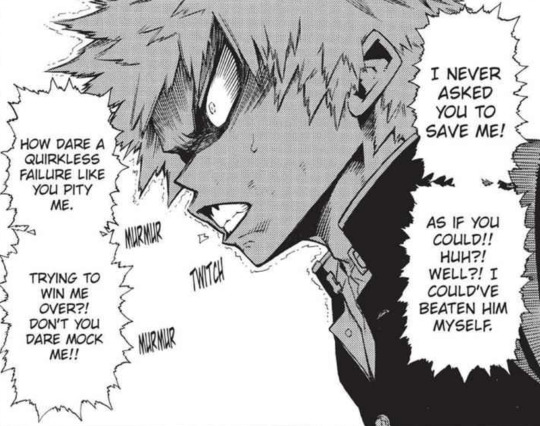
And this all ties back into his insecurities about his role in All Might's downfall. All of this was a major point of what "Deku vs Kacchan, Part 2" was all about.
It's something I dissected a long time ago here:
So it's not that Katsuki wants to protect Izuku; Katsuki doesn't want to be the reason for Izuku's downfall.
And here:
Katsuki lightens Izuku’s load by looking out for everyone else, and this is why Katsuki works so well as Izuku’s weakness. He’s become the cornerstone of Izuku’s house of cards. As much as he hates being a weakness, Katsuki can’t just make it stop by telling Izuku not to care. Izuku will keep on caring regardless. So instead Katsuki has to convince Izuku that Katsuki is stronger so Izuku will keep chasing after him. Izuku needs to believe Katsuki is stronger in order to get stronger himself. Katsuki needs Izuku to believe Katsuki can handle himself, that Izuku can trust him, so they can work as a team and compensate for each other’s weaknesses.
Katsuki acknowledges in his apology in chapter 322 that Izuku is on the right path, that all his moves since receiving OFA have been correct. Katsuki has been a roadblock hindering Izuku and holding him back--yes, often by rejecting him and competing maliciously with him, but also by being too weak to stand at Izuku's side. He was caught by the sludge villain, kidnapped by the League of Villains, lethally stabbed and later nearly killed by TomurAFO. He wasn't the strong hero like All Might that fought to win and save the day. He wasn't an equal partner.
What I read when Katsuki says he won't get in Izuku's way anymore is that he's done it, he's strong enough to stand at Izuku's side, he's strong enough to let Izuku do what he does best, he's strong enough to support Izuku as Izuku strives to achieve what only he can achieve. AND I read Katsuki saying "I am no longer that weak person, I am no longer a burden, I am no longer NOT a hero, no longer NOT the hero I needed to be."
"I won't be a weakness others can exploit to get to you anymore."
(And I read that he's ready to let Izuku be the main character.)
#ask pika#signed ask#bitchlessbkg#my hero academia manga spoilers#final arc spoilers#katsuki bakugou#meta
490 notes
·
View notes
Text

Marat — a cigarette with a taste of liberty, equality and fraternity
That's the translation of this little satire that I found randomly in issue n. 406 of the Brazilian newspaper O Pasquim (1969-1991), a periodical that was part of Brazil's alternative press during the years of the country's military dictatorship. The picture here apparently refers to a kind of advertisement for a supposed cigarette from the 1970s, branding Marat. The moment I came across this publicity, I was fascinated with the idea of finding out more about this possible and peculiar product - what do you mean there was a Marat cigarette?
In order to dig a little deeper, however, I discovered that the picture is in fact a parody of an actual Marlboro advertisement. In other words, the Marat cigarette unfortunately never existed and was just a silly joke.


The parody was probably made especially for this particular issue of the newspaper, which was all about human rights. The joke related to Marat possibly came from an association of the theme with the ideals of the Revolution and the Déclaration des Droits de l'Homme et du Citoyen. And although the mystery has been solved, one question remains: who was the journalist responsible for this simply brilliant idea?
#marat cigarette#i'd smoke if cigarettes were like that#marat#frev#french revolution#jean paul marat#my posts
61 notes
·
View notes
Note
This has been on my mind a lot lately, but I couldn't find anything about this. I saw a data that says young people regardless of gender feel more lonely especially after covid. But articles everywhere describe the phenomenon as male loneliness epidemic. Is it true that loneliness affect men more than women?
Yes, I've noticed this as well! (It's definitely frustrating!)
In short, no, women and men experience similar amounts of loneliness. (Therefore, it should simply be a "loneliness epidemic" not a "male loneliness epidemic".)
First:
A pre-covid meta-analysis [1] concluded that "across the lifespan mean levels of loneliness are similar for males and females". This is a robust finding because a meta-analysis synthesizes the results from many different studies; this one covered 39 years, 45 countries, and a wide range of other demographic factors from a total of 575 reports (751 effect sizes).
An interesting longitudinal study [2] used both indirect and direct measures of loneliness and (essentially) found no significant effect of sex. (But there were some interesting interaction effects between sex and age or sex and loneliness measure, if you want to look at the study!)
This literature review [3] states that "sex differences in loneliness are dependent on what type of loneliness is measured and how" and it's possible sex only "correlates with other factors that then impact loneliness directly". The first quote here is referring to similar sex-age/sex-measurement interactions found in [2].
During/after the COVID-19 pandemic however:
The earlier review [3] stated that "most studies found that women were lonelier or experienced higher increases in loneliness than men with both direct and indirect measures", but this may be a result of participant selection bias during the pandemic.
That being said, both a rapid review [4] and a systematic review and meta-analysis [5] found that women were either more or equally likely to report loneliness during the COVID-19 pandemic.
In addition, the Pew Research Center has collected some relevant data:
Prior to the pandemic, 10% of both men and women in the USA reported feeling lonely all or most of the time [6].
And while this doesn't measure loneliness directly, 48% of women and 32% of men in the USA reported high levels of psychological distress at least once during the pandemic [7].
References below the cut:
Maes, M., Qualter, P., Vanhalst, J., Van Den Noortgate, W., & Goossens, L. (2019). Gender differences in loneliness across the lifespan: A meta–analysis. European Journal of Personality, 33(6), 642–654. https://doi.org/10.1002/per.2220
Von Soest, T., Luhmann, M., Hansen, T., & Gerstorf, D. (2020). Development of loneliness in midlife and old age: Its nature and correlates. Journal of Personality and Social Psychology, 118(2), 388–406. https://doi.org/10.1037/pspp0000219
Barjaková, M., Garnero, A., & d’Hombres, B. (2023). Risk factors for loneliness: A literature review. Social Science & Medicine (1982), 334, 116163. https://doi.org/10.1016/j.socscimed.2023.116163
Pai, N., & Vella, S.-L. (2021). COVID-19 and loneliness: A rapid systematic review. Australian & New Zealand Journal of Psychiatry, 55(12), 1144–1156. https://doi.org/10.1177/00048674211031489
Ernst, M., Niederer, D., Werner, A. M., Czaja, S. J., Mikton, C., Ong, A. D., Rosen, T., Brähler, E., & Beutel, M. E. (2022). Loneliness before and during the COVID-19 pandemic: A systematic review with meta-analysis. American Psychologist, 77(5), 660–677. https://doi.org/10.1037/amp0001005
Bialik, K. (2018, December 3). Americans unhappy with family, social or financial life are more likely to say they feel lonely. Pew Research Center. https://www.pewresearch.org/short-reads/2018/12/03/americans-unhappy-with-family-social-or-financial-life-are-more-likely-to-say-they-feel-lonely/
Gramlich, J. (2023, March 2). Mental health and the pandemic: What U.S. surveys have found. Pew Research Center. https://www.pewresearch.org/short-reads/2023/03/02/mental-health-and-the-pandemic-what-u-s-surveys-have-found/
36 notes
·
View notes
Note
Hi, it's me again! I just read through the daughter hc (and all others cuz I'm so normal for Morgott) and I had a random ahh scene in my mind!
Imagine if his daughter got her father's elegance and her mother's (let's just say... brashness.)
Just imagine the curses she'll utter like, "Thy mother is a bi—" (or smth like that.)
(i swear it's funnier in my head)
I LOVE YOU I COULD KISS YOU THIS IS SO SMART
I am gifting you this mini fic for this idea <3 (I gave the daughter a name, hope y'all don't mind <3) also, not proofread!
quick sidenote: Scullion is a servant of the lowliest tasks and is often used as an insult akin to degeneracy
wc: 406 tw: language warning
Bold Elegance
Ariah was a bold child, and Morgott was none the wiser to this. She ALWAYS wore an innocent facade around him. Today, however, that would change. And certainly not intentionally.
Their family was no stranger to cruel names and stares accompanied by unkind whispers. Ariah could only ever put up with so much of it. If it was directed toward her, that was fine. But the moment she heard a snicker followed with her mother being called a whore for having children with an omen... oh boy...
Ariah completely forgot that she was in the market with her father as she whipped around to face the aggressor, her nostrils flared and her pupils restricted. The words fell off her lips before she could even think. How dare they accuse her mother of such a thing?!
"Thy tongue is sullied by such words, one wouldst think thou wert a scullion! Prithee, speak of mine mother in such a manner again and I shall rip thy nasty lips from thy face, bastard-"
The shocked expression that flashed over her father's face was priceless. Where on EARTH had she learned to speak this way? He quickly grabbed her by the ear and pulled her away. While he was a doting father, he was equally as strict. He would not stand for his daughter using such foul language. As he pulled her out of sight, he let go of her ear and folded his arms over his chest, an unamused expression, bordering disappointment, written in his features.
"Where, pray tell, hast thou learned to speak in such a manner?!"
Morgott questioned her, his face screwed up with distaste at the thought.
"Thou art royalty, thy words are disgraceful for such a standing!"
Although Morgott hated scolding his daughter, he attempted to keep himself steeled with authority. It was so hard when he watched the way his daughter shrunk away from him and averted her gaze. He had to remind himself that he had centuries of time to grow accustomed to the colorful insults people spread about him, she was merely a teenager she did not have such experience under her belt. Morgott let out a quiet sigh.
"And yet I am reminded that thou art simply a child... I shall extend thee grace but once. Do not let this occur again, understood?"
Ariah nodded slowly, relieved that no punishment would befall her... Oh, he was so wrapped around her finger...
#morgott#elden ring#elden ring morgott#morgott the grace given#morgott the omen king#he loves her so much#help this is so cute#medieval insults are so funny
22 notes
·
View notes
Text
decided to lay out a few theories that have been solidified for me after watching the trailer!
1) nirmala is getting married. according to an article she has a love interest this season, someone who makes sandwiches, and considering all three vishwakumar girls are sitting on the side for the wedding, i think it’s basically confirmed. also, it’s supposed to be unexpected. can’t think of anything else more unpredictable than pati giving love another chance.
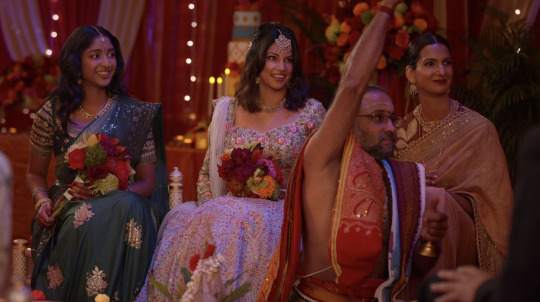
2) the ethan storyline will fizzle out by 405, 406 or 407 maximum. apparently, according to the writers, he has quite a temper, a classic bad boy of sorts. i assume he has something to do with the crude vandalism written on devi’s car after they break up.
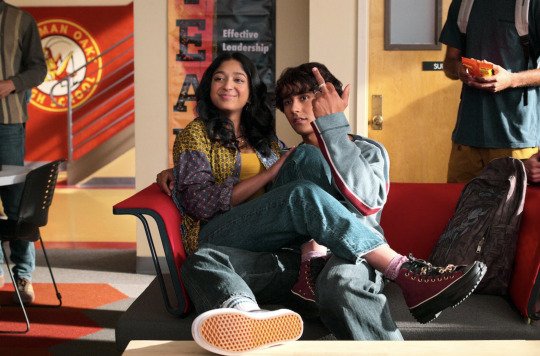

3) paxton will give university a chance and decide it’s not for him in 403. i wouldn’t consider this as being regressive, as uni is not the path for everyone. he will work as a swim coach and advisor back at sherman oaks, therefore bringing him back into the love triangle (and also making things easier for the writers to keep him in the story).


also, #trexton4life.
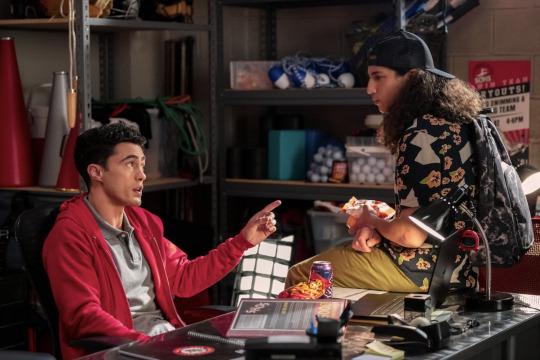
4) ben and margot break up early on. due to the still of ben and margot below, i theorize devi may accidentally start a scene during this, and bring attention to their conversation. how? i’m not sure.
i’ve never pegged margot to be the type of girl who tolerates any level of bullshit. so i don’t doubt she’ll take herself out of the relationship if there is ex mess involved. either way, don’t think they’re lasting in any way shape or form. mildly sucks because i loved her friendship with ben in s3 but whatever
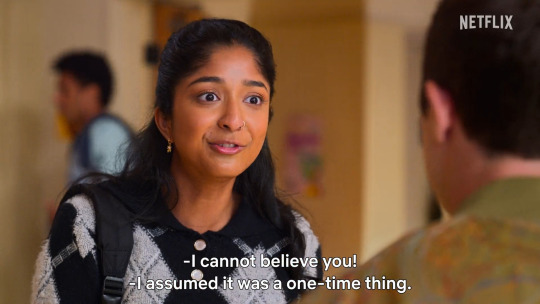
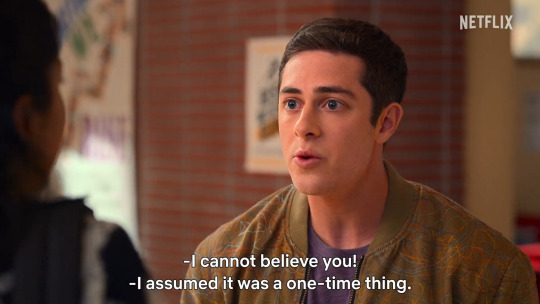

5) ben and devi will not be on talking terms until 405. regarding why they’re still icing each other out, i’m assuming whatever incident happens in theory 4 above is why ben appears to be ignoring devi, and she is equally mad at him. the still below is from 403.
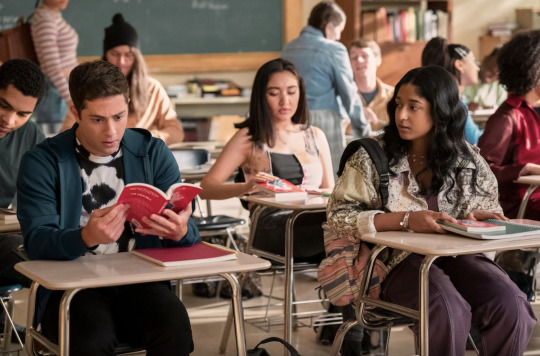
they patch things up during 405, specifically the scene at the bar when ben sees devi being harassed (?) and helps her out. maybe we’ll get a moment of devi icing ben’s bruise while they finally reconcile. they will NOT get together romantically this early, but will be back on bestie terms. refer to most of s3 benvi for dynamic.



6) eleanor pursues acting in new york and succeeds, which may drive a wedge into her relationship with trent. however, they will last. i also have a slight suspicion this is an eleanor pov episode.
she might also run into her mother due to that scene in the teaser where she is very visibly upset in the same outfit.
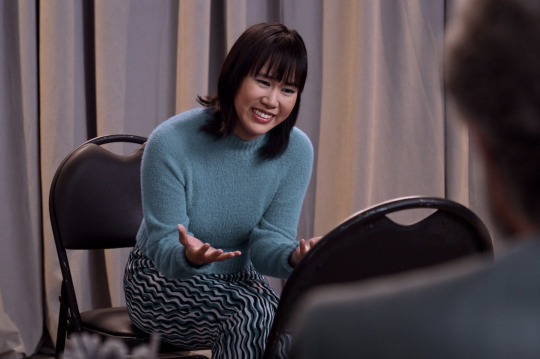

7) swimming will be the connection between devi and paxton, as maybe devi gives it another try. she’s said to be in her speedos in a leak during the middle of the season which i assume means she’ll join the swim team again.

this still below is in 407. they might have a moment of rekindling romance here. however, considering how different devi and paxton’s paths are and also the fact that he is now a staff member and she is a student, it doesn’t quite make sense for them to work out realistically or enter a relationship, more on that later. won’t make any guesses further than that, though.
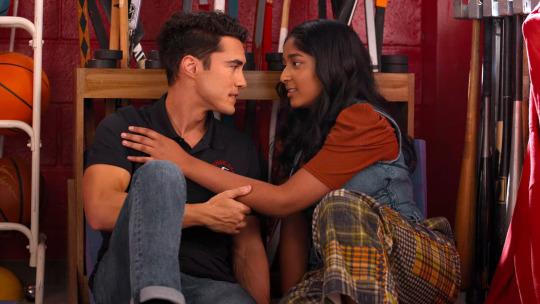
8) devi, fab, and el will not make it to prom. the car crashes. they’re sitting on it while it’s night. that insinuates that they either make it very late or not at all.
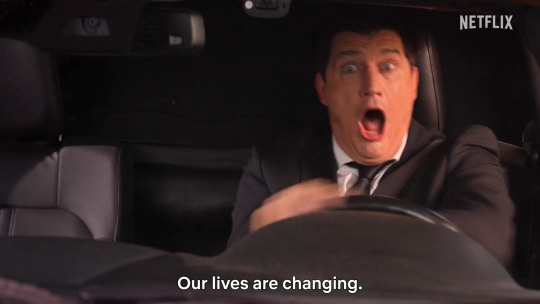
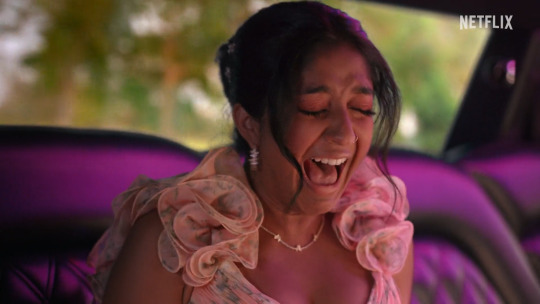

9) ben climbs through devi’s window after prom to comfort her. he knows very well how much prom has meant to devi since they were kids and probably understands how much this must suck for devi. he’s also not in a suit which may mean he also could not go to prom. i won’t speculate the reason but it could be related to the altercation at the club if it was during a school field trip, maybe not. either way, they will finally have a proper conversation about their feelings.
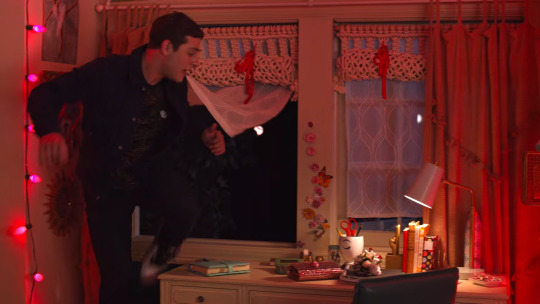
however a) i don’t think they will say their i love you’s here but either way, b) i have a slight feeling they might have sex, this time doing it because they feel it’ll work out and out of love, without any sort of miscommunication. the awkwardness from 401 will not be there post coital antics.
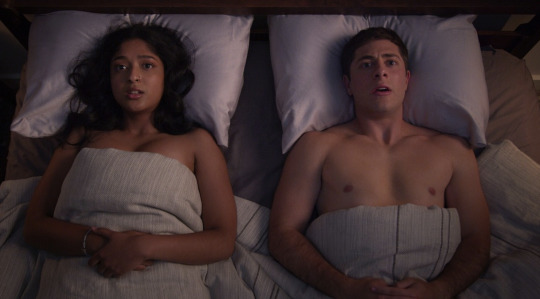
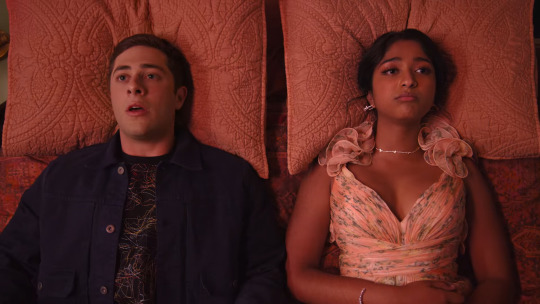
there is also the chance that this entire scene is a dream. i wouldn’t put that past the show because ben has never been the type to climb through devi’s window. however, it is sweet considering how willing ben is to step out of his comfort zone when it comes to her, so i choose to believe it’s real for narrative sense.

10) ben and devi have some sort of prom retry in 410, maybe in the last few minutes of the show, and their final love confessions happen here. the last scene maitreyi and jaren filmed was in a library, and she had a corsage on her wrist after wrapping. as mentioned before, attending prom meant a lot to devi and ben knows of this fact. as for the place, probably their college library, assuming they both go to the same place for post secondary education.
EDIT: it's also possible the library scene is a timeskip into the future. we shall see.
shows do film out of order, and the corsage could have been unrelated to onscreen plot. so as of right now, it’s just speculation
it is important to note that i do not want to assume who is endgame, as i try not to set any expectations. but personally, i don’t understand how devi and paxton would work from here if devi is going to university and paxton is staying at sherman oaks. her future seems to align with ben’s more. writing wise, and just logically, it would make more sense.
anyway, if i think of any more i’ll add them! thanks for entertaining my delusions ideas.
#never have i ever#nhie#nhie s4#theories and predictions#devi vishwakumar#ben gross#nalini vishwakumar#paxton hall yoshida#kamala nandiawada#eleanor wong#fabiola torres#<- there are theories i have about her but they relate to leaks that are very much fact rather than prediction#and i don't want to include anything that hasn't been said in the trailer that will definitely happen#wink wink princeton leak#also where the hell is#aneesa quereshi#this entire time#anyway#ben x devi#devi x paxton#benvi#bevi#daxton#mainly team ben aligned#but i tried to stay neutral and just analyze the plot from whatever they've given us#meta#nhie s4 spec
245 notes
·
View notes
Text

Access For All. Period.
Free pads and tampons are now available throughout Manitoba as part of the Access for All Period program, led by the Manitoba government. This program is focused on ending period poverty by providing equal access to menstrual products for all.
What is period poverty?
Period poverty is the inability to access or afford menstrual products, preventing youth and adults who menstruate from participating in their everyday lives.
Why is this important?
Removing barriers to access menstrual products is crucial to the physical and mental health of all who menstruate. A lack of proper access can result in dangerous situations, leading to both short and long term physical harm, as well as mental health issues including anxiety, depression and self-isolation. For students, it can negatively impact attendance and participation, affecting long-term achievement and resulting in missed educational and employment opportunities.
How does the program work?
The Manitoba government, in partnership with Shoppers Drug Mart, is providing readily available pads and tampons free to those in need. Products are available to all Manitobans in schools and community organizations as listed below. Free menstrual products are also available at participating shelters throughout the province through the Access for All Period program.
Where can I go?
You can access free menstrual products at the following locations (38 total, 26 in Winnipeg) under the cut:
* Andrews Street Family Centre, 220 Andrews Street, Winnipeg
* Blue Thunderbird Family Care, 998 Sargent Avenue, Winnipeg
* Acorn Family Place, 222 Furby Street #202, Winnipeg
* Canadian Muslim Women's Institute, 61 Juno Street #201, Winnipeg
* Community Ambition, 266A Linwood Street, Winnipeg
* Elmwood Community Resource Centre, 545 Watt Street, Winnipeg
* Family Dynamics, 393 Portage Avenue #401, Winnipeg
* First Nations Family Advocate, 286 Smith Street #200, Winnipeg
* The Food Vault and Community Resource Centre, 24 Hampton East, P.O. Box 881, MacGregor
* Fort Garry Women's Resource Centre, 1150A Waverly Street, Winnipeg
* Holy Names House of Peace, 211 Edmonton Street, Winnipeg
* Interlake Women's Resource Centre, 87 - 5th Avenue, Gimli
* Lakeshore Family Resource Centre, 9 Main Street, Ashern
* Madeline's Closet, 40 Main Street, Inwood
* Ma Mawi Wi Chi Itata Centre, 445 King Street, Winnipeg
* Marlene Street Resource Centre, 27 Marlene Street #6, Winnipeg
* Men are Part of the Solution (MAPS), 117B Commercial Place, Thompson
* N'Dinawemak, 190 Disraeli Freeway, Winnipeg
* Ndinawe, 472 Selkirk Avenue, Winnipeg
* North End Women's Centre, 394 Selkirk Avenue, Winnipeg
* North Point Douglas Women's Centre, 221 Austin Street North, Winnipeg
* NorWest - A Woman's Place, 945 Notre Dame Avenue, Winnipeg
* NorWest - Community Health, 785 Keewatin Street, Winnipeg
* Pluri-elles, 114-l420 Des Meurons Street, Winnipeg
* Samaritan House, 1610 Pacific Avenue, Brandon
* South Winnipeg Family Information Centre, 800 Point Road, Winnipeg
* Steinbach Family Resource Centre, 101 North Front Drive, Steinbach
* Swan Valley Crisis Centre, 119 9th Avenue North, Swan River
* The Counselling Centre, 335 9th Street, Brandon
* The Pas Family Resource Centre, 103 Edwards Avenue, The Pas
* Thrive Community Support Circle, 3-406 Edmonton Street, Winnipeg
* Wahbung Abinoonjiiag, 225 Dufferin Street, Winnipeg
* Winnipeg Central Park Women's Resource Centre, 400 Edmonton Avenue, Winnipeg
* Women's Safe Haven, 228-35 Main Street, Flin Flon
* West Central Women's Resource Centre, 640 Ellice Avenue, Winnipeg
* Western MB Women's Regional Resource Centre, 729 Princess Avenue, Brandon
* YMCA Winnipeg (Downtown Branch) 301 Vaughan Street, Winnipeg, (West Portage Branch) 3550 Portage Avenue, Winnipeg
8 notes
·
View notes
Text

B.3.5 Is state owned property different from private property?
No, far from it.
State ownership should not be confused with the common or public ownership implied by the concept of “use rights.” The state is a hierarchical instrument of coercion and, as we discussed in section B.2, is marked by power being concentrated in a few hands. As the general populate is, by design, excluded from decision making within it this means that the state apparatus has control over the property in question. As the general public and those who use a piece of property are excluded from controlling it, state property is identical to private property. Instead of capitalists owning it, the state bureaucracy does.
This can easily be seen from the example of such so-called “socialist” states as the Soviet Union or China. To show why, we need only quote a market socialist who claims that China is not capitalist. According to David Schweickart a society is capitalist if, ”[i]n order to gain access to means of production (without which no one can work), most people must contract with people who own (or represent the owners of) such means. In exchange for a wage of a salary, they agree to supply the owners with a certain quantity and quality of labour. It is a crucial characteristic of the institution of wage labour that the goods or services produced do not belong to the workers who produce them but to those who supply the workers with the means of production.” Anarchists agree with Schweickart’s definition of capitalism. As such, he is right to argue that a “society of small farmers and artisans .. . is not a capitalist society, since wage labour is largely absent.” He is, however, wrong to assert that a “society in which most of [the] means of production are owned by the central government or by local communities — contemporary China, for example — is not a capitalist society, since private ownership of the means of production is not dominant.” [After Capitalism, p. 23]
The reason is apparent. As Emma Goldman said (pointing out the obvious), if property is nationalised “it belongs to the state; this is, the government has control of it and can dispose of it according to its wishes and views … Such a condition of affairs may be called state capitalism, but it would be fantastic to consider it in any sense Communistic” (as that needs the “socialisation of the land and of the machinery of production and distribution” which “belong[s] to the people, to be settled and used by individuals or groups according to their needs” based on “free access”). [Red Emma Speaks, pp. 406–7]
Thus, by Schweickart’s own definition, a system based on state ownership is capitalist as the workers clearly do not own the own means of production they use, the state does. Neither do they own the goods or services they produce, the state which supplies the workers with the means of production does. The difference is that rather than being a number of different capitalists there is only one, the state. It is, as Kropotkin warned, the “mere substitution … of the State as the universal capitalist for the present capitalists.” [Evolution and Environment, p. 106] This is why anarchists have tended to call such regimes “state capitalist” as the state basically replaces the capitalist as boss.
While this is most clear for regimes like China’s which are dictatorships, the logic also applies to democratic states. No matter if a state is democratic, state ownership is a form of exclusive property ownership which implies a social relationship which is totally different from genuine forms of socialism. Common ownership and use rights produce social relationships based on liberty and equality. State ownership, however, presupposes the existence of a government machine, a centralised bureaucracy, which stands above the members of society, both as individuals and as a group, and has the power to coerce and dominate them. In other words, when a state owns the means of life, the members of society remain proletarians, non-owners, excluded from control. Both legally and in reality, the means of life belong not to them, but to the state. As the state is not an abstraction floating above society but rather a social institution made up of a specific group of human beings, this means that this group controls and so effectively owns the property in question, not society as a whole nor those who actually use it. Just as the owning class excludes the majority, so does the state bureaucracy which means it owns the means of production, whether or not this is formally and legally recognised.
This explains why libertarian socialists have consistently stressed workers’ self-management of production as the basis of any real form of socialism. To concentrate on ownership, as both Leninism and social democracy have done, misses the point. Needless to say, those regimes which have replaced capitalist ownership with state property have shown the validity the anarchist analysis in these matters (“all-powerful, centralised Government with State Capitalism as its economic expression,” to quote Emma Goldman’s summation of Lenin’s Russia [Op. Cit., p. 388]). State property is in no way fundamentally different from private property — all that changes is who exploits and oppresses the workers.
For more discussion see section H.3.13 — “Why is state socialism just state capitalism?”
#private property#state property#personal property#community building#practical anarchy#practical anarchism#anarchist society#practical#faq#anarchy faq#revolution#anarchism#daily posts#communism#anti capitalist#anti capitalism#late stage capitalism#organization#grassroots#grass roots#anarchists#libraries#leftism#social issues#economy#economics#climate change#climate crisis#climate#ecology
2 notes
·
View notes
Text
putterings, 406-405
the first step on the road to salvation is a job-lot of flagstone, Amazing New Kind of widely read and reflected, you might even say disconnected facts juggling all words of equal value, a half-acre lot situated on an idea Oh look, a squirrel!
puutterings | their index | these derivations | 20240229
3 notes
·
View notes
Photo

Site name and link: Charmingly Splendid, https://ecs.jcink.net Site genre: Based On TV Show Site info: Charmingly Splendid is a Charmed AU roleplay site based in modern era. Our plot started in between season 2 - 3, before we lost Prue Halliwell, most of the story from here onward is our creation so regardless if you've watched Charmed or not, you'll be able to make a character to fit into this new world we are creating. Your name: Paige Contact info: Discord Paige Yin#0119 Role(s) requested: All characters requested below would have plotting opportunities with my character(s), sometimes multiple of them and might be involving in some major site plot if you choose to use them that way. Some of these characters has a more complex plots that I'd like to work out, while others are more open. Either way, you may always contact me on Discord and we can hash out the ideas either of us have and make an even better, funner plot to write! Looking forward to chatting with you!
For Keenen Bauknecht

Kiefer Bauknecht ❥ Original ❥ Demon ❥ 406 years old ❥ Open profession
Meet Kiefer, older twin brother of Keenen who's also the Demon of Dreams. His power is similar to Keenen's although with a little twist. Kiefer's ability would be able to influence dreams, however, when it comes to creating nightmare/ twisting a good dream into a nightmare, he is slightly weaker compared to Keenen. Most of Keenen's history with his brother is listed on Keenen's app, long story short, the were born in currently Bamberg, Germany, from a long line of witches and warlocks. The family was nice and happy until they the witch hunt caught up to them and condemned them all to die. Burned to death, Keenen and Kiefer became a pair of demons. Their transformation and the abilities over someone's dreams are a manifestation of their mortal conjuring and hallucikinesis abilities. Keenen and Kiefer are not in good term right now, Keenen is jealous of his big brother's goodness while he prefers to walk the darker path in life. All the rest that's not mentioned here or in the application, you'll have free reign to create. Face claim, I'd suggest Janis Danner, but I am not 100% set on that! It's just because they are twins so I figured that they could share similar face! But if you'd like alternative choices (I can't provide any of German descend), I'd recommend Lucas Bravo (esp if you're keen on having someone more mainstream and have tons of gifs), Valentin D'Hoore and Giorgos Mavrogiannis.
For Haori Tsukioka This is a request for the Tsukioka siblings. Brief intro on the family, the Nomura is quite a renowned and respected family in Japan, especially in the Sorcery profession/ Sorcery world (魔道). Their father, Aoshi Tsukioka, is stern and a bit of a sexist/ genderist (this is quite common in the culture) so he wants to get a boy to pass his knowledge onto. To the girls, even though he doesn't have as high an expectation from them, he does expect a lot from them, like to excel academically and otherwise; their mother, Kiku Ohara, is a quiet lady, gentle but also obedient and careful. I can see her being very kind towards everyone equally, though she won't go against their father's words. Their parents have no love for each other, their marriage were arranged by their parents since before birth. The Tsukioka has 4 children, 3 girls and a boy. Of course, the boy would be getting all the attentions from their father as well as all the responsibilities. I am playing the oldest sister, haori tsukioka, who's like a typical first born: confident, outspoken, protective, and like, never really fear of anything. She is pretty close with most of her siblings, but I am also open for conflict, perhaps one of her siblings (maybe the boy) dislike and envy her (and the rest of the girls) for the freedom he could never have. If you have any questions about the plot, the family, the characters, Japanese's culture, feel free to poke me via DM or Discord.

Saori Tsukioka ❥ Original ❥ Witch/ Human ❥ 28/ 29 ❥ Middle Sister ❥ Open profession
I always feels Saori being a little more reserve and quiet as a middle sister. She probably wasn't too confident in her middle/ high school year and needed Haori to help her come out of her shell, but she can go the total opposite way as well! If she was the quiet/ shy one, I can see her having that big-sis worship syndrome and followed Haori to the States when her big sister had the chance. She could also be the down-to-earth one who constantly try to keep Haori from getting into troubles or spending too much. FC suggestion: Tao Tsuchiya (image), Kasumi Arimura, Emi Takei, Tao Tsuchiya, Alice Hirose, Haruna Kawaguchi, Yuko Araki, Nana Komatsu.

Minori Tsukioka ❥ Original ❥ Witch/ Human ❥ 24/ 25 ❥ Youngest Sister ❥ Twin: Yuori Tsukioka ❥ Open profession
I can see Minori being the baby of the family, a little spoiled, a little whinny, but also pretty out-going and confident and kind of a wild child. I can see her being closest to Yuori and actually be able to understand her twin brother better than the other two sisters. If you want to take her and have drama, we can totally have her ran away with Yuori to the States and never wanted to go back home ever since. I picked Tao as FC because there are tons of GIFs and photos of her in kimono, which is what all the Nomura children will be wearing when they are back at their Japan home (their family is traditional like that). FC suggestion: Ayaka Miyoshi(image), Minami Hamabe, Sakurai Hinako, Ayami Nakajo, Suzu Hirose, Mei Nagano, Nana Komatsu.

Yuori Tsukioka ❥ Original ❥ Witch/ Human ❥ 24/ 25 ❥ Youngest Brother ❥ Twin: Minori Tsukioka ❥ Open profession
The youngest brother, but also, the only boy in the family and he probably got tons of pressure to be perfect and learn 魔道 (ways of Magic) with his dad. He is supposed to be the next generation of socerer for the Tsukioka family. I can see him getting stressed out, and eventually rebel. You can either have him be obedient and follow the path arrange by their father, or rebel and decided to go his own way. Either way, Haori will be supportive of his path! Similar with Tao, I picked Ryusei as FC because there are tons of GIFs being in Kimono or suits, which are the main attire when the Nomura's are home in Japan. FC suggestion: Ryusei Yokohama (image), Mackennyu, Takumi Kitamura, Taishi Nakagawa, Gordon Maeda, Keisuke Watanabe, Eiji Akaso, Sano Hayato, Seto Toshiki, Inukai Atsuhiro.
#jcink rp#jcink premium#character request#real life#supernatural#based on#multi-genre#platonic#familial#professional
3 notes
·
View notes
Text
However, as Cambiano puts it, “The (Classical) tragic theatre was full of noble characters who had suddenly been enslaved. The cause was found either in fate or chance or in punishment by the gods.” Indeed, Euripides’ (c. 484—406 BCE) plays The Trojan Women, Andromache, and Hecuba— all set in the Homeric age but produced in Athens’ Classical period— feature a cast of protagonists who are enslaved despite their membership in the Trojan royal family. Over the course of these plays, the Trojan Women frequently lament their enslavement, and are represented in ways meant to inspire pity. However, as Wrenhaven notes, Euripides repeatedly differentiates the enslaved Trojan Women from common slaves by a variety of factors, all of which the Trojan princess Polyxena demonstrates in two key scenes. The first is when she considers whether she would prefer being sacrificed or enslaved by her Greek captors: Why should I go on living? My father was the king of all the Phrygians… Then I was nourished by fair hopes as a bride for kings, and many were the rivals who competed to take me off to their hearth and home as their wife. I— now so unfortunate— was a mistress to the women of Ida. Among those women, both young and old, it was I who attracted all men’s gaze. Mortality apart, I was the equal of the gods. But now I am a slave. First of all, the strangeness of that name makes me long to die. Then I may perhaps have a cruel master who will buy me for silver, me the sister of Hector and of many others, force on me the task of making bread in his home, and impose the daily drudgery of sweeping the house and standing by the loom. And a slave bought from I know not where will defile my bed, which was once thought worthy of princes. No, it cannot be. I consign my body to Hades and take my last look on this daylight with eyes that are free (Hec. 348—370). As Wrenhaven notes, Polyxena finds the thought of enslavement repulsive not because the institution is unjust, but because she herself does not deserve it due to her lineage, nobility, preoccupation with marriage, modesty, former betrothment to fellow nobles, and victimization by fortune. In addition, Polyxena continues her self-description by emphasizing her beauty, and then ends it by flatly stating that the combination of these traits once rendered her an “equal of the gods.” Moreover, after Polyxena chooses to be sacrificed, she exposes her neck and abdomen to her sacrificers, an act which Euripides describes in the following way: “Her lovely breasts and bosom were revealed like a statue’s” (559—561). Although Euripides does not specifically say that the statue he compares Polyxena to depicts a deity, as the novelists often do, this would be consistent with his characterization of her as divine elsewhere. Thus, Euripides has Polyxena link beauty and divinity with fitness for mastership. This, coupled with the emphasis on how much his protagonists despise their enslavement, serves to portray slavery as an undesireable condition for the aristocratic elite. However, this is not a criticism of enslavement in general. By specifying that slavery is undesireable or unjust for enslaved elites, or masters by nature, both Aristotle and Euripides argue in turn that slavery is just and desirable for the common slave, or the slave by nature. As such, their shared concern for the enslaved does not challenge ideologies of slavery broadly, but only specific cases wherein it has been applied to the wrong type of person.
Slaves by Nature, Enslaved by Love: Receptions of Aristotle and Euripides in the Ancient Greek by Adrian Walls, pg 12-14.
This is an interesting concept. Much has been said about Polyxena's sacrifice in terms of tragedy (I don't need to explain why this is a tragic theme, I presume), gender (female sacrifice in Greco-Roman mythological narratives) and parallels (Iphigenia), but I I hadn't seen anyone comment on Polyxena's feeling about not despising the slavery system itself, but rather the fact that she, despite her nobility, is subjected to it. It makes sense, after all, the Trojan royal family did have slaves, as indicated in, for example, fragments of Sophocles’ plays (see Troilus fragments), Euripides' plays (see Alexandros fragments) and in Lycophron's poem Alexandra. And when we think about enslaved characters, usually the ones whose situations are portrayed as tragic are those who were well-known noble/royalt figures. For example, the slaves who constantly save exposed babies aren't depicted as tragic or have any relevance once the baby grows up (I'm talking about stories like Oedipus, Neleus and Pelias, Paris, etc) and of Helen's servants the only one whose servant/enslaved status is relevant is Aethra (notably, a princess and mother of a well-known hero), etc. That Greek mythology, as indeed many myths do, has a habit of focusing on people of high status is obvius, but it's still shocking that even in a topic like slavery the slaves who were common people by birth (i.e. not nobles, royalty, etc) aren't the emphasized. They're usually treated with indifference (e.g. Agelaus, the man who saved Paris), are portrayed negatively because they aren't loyal to the masters who enslaved them (e.g. The Odyssey), or are portrayed positively because they're loyal to their masters and are even willing to go against other slaves because of this loyalty (e.g. The Odyssey). And that's it.
While I don't think the play Hecuba itself is enough of an argument to be sure whether this was the thought of Euripides (it's certainly easier to suggest ideas about characters' thoughts than actual people), it does make sense that it was Polyxena's thought. In a way, it's quite predictable coming from Ancient Greece, but it's still an interesting thing to point out. Polyxena isn't to blame for the Trojan War and is also a victim in this context, but she, like the people of her time (especially royalty), still had thoughts like this.
1 note
·
View note
Text
George Brett: The Legend of Kansas City Baseball
When you think of Kansas City Royals baseball, one name immediately comes to mind — George Brett. A Hall of Famer, 13-time All-Star, and one of the greatest hitters in the history of Major League Baseball, Brett’s legacy is forever intertwined with the Royals organization. His passion, intensity, and consistent excellence made him an icon not just in Kansas City, but in the entire baseball world.
From his legendary pursuit of a .400 batting average to his infamous “Pine Tar Incident,” George Brett’s career is filled with memorable moments that have solidified his place as one of baseball’s all-time greats. In this blog, we’ll take a closer look at his incredible journey, his defining moments, and his lasting impact on the game.
Early Life and Rise to the Majors
George Howard Brett was born on May 15, 1953, in Glen Dale, West Virginia, but he grew up in Southern California. A natural athlete, Brett excelled in baseball from an early age, playing alongside his older brother, Ken Brett, who would also go on to play in the major leagues. It wasn’t long before George Brett’s talent caught the eye of scouts.
In 1971, at the age of 18, Brett was drafted by the Kansas City Royals in the second round of the MLB Draft. After spending a few years in the minor leagues honing his skills, Brett made his MLB debut with the Royals in 1973. Initially a shortstop, Brett would eventually shift to third base, where he became one of the best in the league.
The Pursuit of .400: A Historic 1980 Season
Brett’s career truly hit its peak in 1980, a season that is still talked about as one of the greatest individual performances in MLB history. That year, Brett flirted with baseball immortality as he pursued the elusive .400 batting average — a mark that hadn’t been achieved since Ted Williams hit .406 in 1941.
Throughout the summer of 1980, Brett’s bat was unstoppable. He consistently delivered at the plate, thrilling fans and leaving pitchers bewildered. By late August, Brett’s average sat at .407, and it looked like he might achieve the unthinkable. Although his average dipped slightly in September, Brett finished the season with an astonishing .390 batting average, the highest in the majors since Williams’ iconic season.
Brett’s remarkable performance earned him the American League MVP Award in 1980, as well as the adoration of baseball fans across the nation. His chase for .400 remains one of the most thrilling individual accomplishments in the history of the sport.
The Pine Tar Incident: Controversy and Infamy
While Brett’s .390 season remains a defining moment of his career, he’s perhaps equally well-known for a singular moment of controversy: The Pine Tar Incident. On July 24, 1983, during a game against the New York Yankees at Yankee Stadium, Brett hit a go-ahead, two-run home run in the top of the ninth inning off Goose Gossage, giving the Royals a 5–4 lead.
However, Yankees manager Billy Martin contested the home run, claiming that Brett had too much pine tar on his bat. According to MLB rules, pine tar couldn’t extend more than 18 inches up the handle of the bat. The umpires examined the bat and, to Brett’s dismay, ruled him out, nullifying the home run.
What followed was one of the most famous reactions in sports history. Brett stormed out of the dugout in a rage, charging at the umpires in disbelief. His anger, and the chaos that ensued, became an unforgettable moment in baseball lore. The ruling was eventually overturned by the MLB, and the game was resumed weeks later with Brett’s home run reinstated.
The Pine Tar Incident, while controversial, showcased Brett’s fiery passion for the game. It also added to his legend, proving that he wasn’t just a great player but a man who played the game with heart, intensity, and a relentless competitive spirit.
World Series Glory in 1985
One of Brett’s crowning achievements came in 1985 when he led the Kansas City Royals to their first-ever World Series title. As the team’s undisputed leader, Brett was instrumental in their success throughout the season and especially during the playoffs.
In the 1985 American League Championship Series (ALCS) against the Toronto Blue Jays, Brett delivered a performance for the ages. In Game 3, with the Royals down 2–0 in the series, Brett hit two home runs, helping the Royals to a 6–5 victory. He finished the ALCS with a .348 batting average, earning ALCS MVP honors and helping the Royals reach the World Series.
In the 1985 World Series, the Royals faced off against their cross-state rivals, the St. Louis Cardinals. Down three games to one, the Royals staged a miraculous comeback, winning the final three games and securing the championship in Game 7. Brett’s leadership and clutch performances were vital to the Royals’ triumph, cementing his status as a Kansas City sports legend.
A Hall of Fame Career
Over his 21-year career, George Brett accumulated some of the most impressive stats in baseball history. He finished with a career .305 batting average, 3,154 hits, 317 home runs, and 1,596 RBIs. Brett was a true five-tool player — he could hit for power and average, field his position with precision, and was a consistent leader on and off the field.
Brett is the only player in MLB history to win batting titles in three different decades (1976, 1980, and 1990), showcasing his longevity and consistency. His ability to adapt and remain competitive for over two decades is a testament to his work ethic and natural talent.
In 1999, Brett was elected to the Baseball Hall of Fame, receiving 98.2% of the vote on his first ballot, an overwhelming endorsement of his greatness.
George Brett’s Legacy
Beyond the numbers and accolades, George Brett’s legacy is defined by his deep connection to Kansas City and the Royals franchise. In an era when players often moved teams, Brett spent his entire career with the Royals, becoming the face of the organization. His loyalty to the team and his contributions to the city of Kansas City made him more than just a baseball star — he became a hometown hero.
Brett remains heavily involved with the Royals organization to this day, serving in various capacities, including as a vice president of baseball operations. His influence continues to inspire younger generations of players and fans alike.
The Ultimate Royal
George Brett wasn’t just a great baseball player — he was the heart and soul of the Kansas City Royals for over two decades. From his pursuit of .400 to his fiery outburst during the Pine Tar Incident, Brett embodied the competitive spirit, talent, and love for the game that defines the best of baseball. His place in the Hall of Fame is well-deserved, and his name will forever be associated with the greatest moments in Royals history.
For fans in Kansas City and beyond, George Brett is more than just a legend — he’s a reminder of what it means to play the game with passion, loyalty, and excellence.
0 notes
Text
To Grandma's House we go! (Wednesday Link Party #406)
Welcome to the To Grandma’s House We Go Link Party #406. My gosh, you guys, how is it already coming to the end of June? We’re still feeling incredibly fortunate for a long spring with plenty of rain and sunshine in equal amounts. Lots of days in the 70s, not too hot, not too cold. We’ve barely used our air conditioner at all and our forecast looks like much of the same. I admit this nice weather…

View On WordPress
#diy#furniture#wednesday link party#link party#to grandma&039;s house we go#frugal#do it yourself#thrift store#featured link#featured links
0 notes
Text
I’m a full time wheelchair user too, and am struggling with this in my city. The only way to bring full and equal access to those with disabilities as it pertains to physical barriers is to make leaders and health facilities be accountable for their “unintentional” discrimination. Know that it is discrimination when you cannot gain full and equal access, even though they say, “I would never discriminate against any one.”
So the only way to enforce enforce our civil rights is through lawsuits……There is no one going around to check to see if policies, procedures and facilities are compliant with the ADA and/or the Rehabilitation Act of 1973. The ADA was originally written that the Federal Government would create an department/board that would inspect and correct violations….however the ADA is now written that we, the disabled with all are limited spoons, are to enforce our Civil Rights.
You can do all three things all at once:
File a complaint with the DOJ by going to ADA.gov. https://civilrights.justice.gov/report/?utm_campaign=499a0d26-884a-47aa-9afc-70094d92e6f5 🎶Note you are NOT “calling the ADA”. The ADA is an act of legislation, not an organization or department a) make sure you have screen shots of your letters b) explain you have not received a response c) state that there is no ADA coordinator listed on the city’s website where you can file a complaint (check first, though!) d) explain exactly what intersections, curb ramps (or lack of), and sidewalks with which you have difficulty navigating. The Attorney General (probably the Assistant Attorney General) for your Federal District Court will review your complaint and determine if it is viable to investigate to see if your city is in violation of Section 504 of the Rehabilitation act of 1973 ( this has more “oomph” than the ADA and applies to Title II entities, like cities, school and hospitals that receive government funding)
2) Contact [insert state name here] Human Relations Commission, as every state has one to help battle and resolve discrimination. Do the same as above. Pictures and videos help. Even writing a physical letter through CERTIFIED MAIL (requires signature) makes you look serious.
3) Find an attorney (they should not charge you one penny for ANYTHING) that will take your case. You can search for attorneys by typing in google search “ada design standards sidewalks, curb ramp [insert state] casetext.com” or “hospital ada wheelchair exam table wheelchair scale Up will pop up lawsuits and usually who is representing the plaintiff (the disabled person). Contact every attorney you can find using this method. Most attorneys represent those who have been discriminated against Section 501 (employment) they do not get into ADA design standard violations, so it’s hard to find them if you don’t google “casetext.com”. Do not go directly to casetext.com The way the attorney gets paid is that the defendant pays all attorney fees…you might even get a small advocate payment for your work. Most firms will not take on Government Entities like cities and schools because they don’t get paid enough….but taking on a Hospital and health facilities that accept Medicaid, yes they would take on those facilities…..usually.
- - - - - - - - - - - - - - - - - -
Again be absolutely clear about barriers of the ADA design standards that you encountered for example
• No curb ramps: §406
• Incline has a slope that is greater than 2.87 degrees/1:20 and there is no ramp: §403.3
• There is a pothole or a gap in between sidewalk panels that has a vertical height change greater than 1/4”: §303.2
• Doors close faster than 5 seconds when the door closing from 90 degrees to 12 degrees: §404.2.8
• Doors that take more than 5 pound of pressure to open (most building codes say 15 pounds of pressure…but even though the facility might be cleared by a code enforcer, code enforcers do not directly enforce the ADA design standards. So, basically if an old, short granny using a walker with a recent hip surgery couldn’t open the bathroom door, then the door is too heavy. You can also use a fish scale to measure this for absolute accuracy if you wish. §404.2.9
• Bathrooms: no accessible toilet stall where a wheelchair can make a parallel approach to the toilet and door stays closed: §604
• Difficulty getting underneath sink §606.2 that points to §305 and §306.
• The lip of the sink is greater than 34” from the floor §606.3
• Mirror is higher than 40” from the floor §603.3
• No exam tables or scale to weigh you with your wheelchair: https://www.ada.gov/resources/medical-care-mobility/
• Accessible parking and their adjoining access aisle that has a slope no greater than 1:48 or 2% and has proper signage. §502.2
Also if you grab the book: ADA Illustrated: a Visualization of the 2010 Americans with Disabilities ACA Standards for Accessible Design by Wyatt Tuell (great guy!), a digital level and a 6 foot measuring tape you can communicate with clear and accurate requests for improvements. For right now, we are the one who enforces the ADA. Hoping policy changes and we don’t have to use our spoons to just get full and equal access to facilities.
Today I had the spoons to hunt down my neighborhood council's email and send them an email that basically said "I would like to be able to leave my house but my neighborhood is not wheelchair accessible. Who do I talk to in order to get this fixed?" And I am planning on hunting down whoever is in charge of sidewalks in my neighborhood and getting real annoying about it.
My plan is to email them every time I want to go somewhere but can't.
Email 1: hello, please fix sidewalks so I can ride the bus places I am very passionate about public transportation and also being able to leave my house.
Email 200: This morning I woke up and wanted some delicious coffee to start my day, but upon getting out of bed I discovered we were out of coffee. I would've liked to take advantage of the city's public transportation system in order to support a local business like [examples of local coffee shops] but alas I cannot because I am a wheelchair user and my neighborhood is not wheelchair accessible. [Insert rest of arguement RE accessibility]. In conclusion I don't work I can keep these emails coming until I die please just fix my sidewalks.
This is going to be my new spite hobby. I was already mad about the abuse and general shit hand the disabled get dealt in our culture but then I started using a wheelchair and places like doctor's offices have been inaccessible to me so now I am filled with rage. So I am going to take that rage and do something with it. Like emailing my city counsel representatives at 2 am like "I crave a moonlight walk fix my sidewalks please."
36K notes
·
View notes
Text
The Mercedes-Benz EQS: A Comprehensive Guide to Features, Specs and Performance

In the rapidly evolving world of electric vehicles, the Mercedes-Benz EQS has emerged as a trailblazer, aiming to challenge the dominance of industry pioneers like Tesla, Porsche, and Audi. As part of Mercedes’ strategic commitment to excellence, the EQS serves as a glimpse into the future of the world’s oldest carmaker, marking its bold move away from the combustion engine. This all-electric luxury sedan is built on Mercedes’ dedicated electric vehicle platform, showcasing the company’s determination to remain competitive in the ever-changing automotive landscape. In this blog, we’ll delve into the distinct design, impressive performance, and innovative features of the Mercedes-Benz EQS, which undoubtedly sets new standards for luxury EVs.
Design – A Vision of the Future
Mercedes has invested considerable effort in crafting the EQS’s design, resulting in an exquisite blend of futuristic aesthetics and aerodynamic prowess. The EQS’s exterior captivates with its distinct features:
Distinctive Front-End Design: The illuminated three-pointed star logo graces the black panel grille, seamlessly merging with the hood to create a sleek front fascia.
Sleek, Coupe-Like Silhouette: Sporting a sloping roofline and a low, wide stance, the Mercedes EQS exudes a sporty and athletic appearance, accentuated by its long, uninterrupted hood and short overhangs.
Aerodynamic Body: The Mercedes EQS boasts an impressive drag coefficient of just 0.20, making it one of the most aerodynamic vehicles available. Its smooth body design, including a streamlined underbody, reduces wind resistance, contributing to improved efficiency.
Unique Lighting Design: The EQS’s “light belt” technology sets it apart, forming a continuous strip of light that elegantly highlights the car’s graceful lines along the side windows, front, and rear.
High-Tech Interior: The Mercedes EQS’s interior is equally captivating, featuring a large, curved 56-inch OLED display that spans the dashboard. The minimalist design, complemented by premium materials such as leather, wood, and metal, creates an ambiance of opulence and sophistication.
Electrifying Performance with Enhanced Efficiency
The heart of the Mercedes-Benz EQS lies in its dual-motor electric drivetrain, delivering electrifying performance and improved efficiency. Let’s explore its key performance aspects:
Base Model EQS 450+: Producing 329 horsepower and 406 lb-ft of torque, this model accelerates from 0 to 60 mph in just 5.5 seconds, offering a thrilling ride that rivals high-performance gasoline-powered sports cars.
More Powerful EQS 580 4MATIC: Equipped with a larger battery and an additional front motor, the Mercedes EQS 580 boasts an impressive 516 horsepower and 631 lb-ft of torque, accelerating from 0 to 60 mph in just 4.1 seconds.
Agile Handling: Thanks to its low center of gravity and advanced suspension system, the Mercedes EQS exhibits excellent handling and driving dynamics. Standard air suspension automatically adjusts to road conditions, providing a smooth and comfortable ride. Rear-wheel steering further enhances maneuverability at low speeds and stability at high speeds.
Impressive Range: The Mercedes EQS offers exceptional range figures, with the base model EQS 450+ offering up to 400 miles of range on a single charge (based on WLTP testing). Meanwhile, the EQS 580 4MATIC provides up to 360 miles of range. Its 107.8 kWh battery pack can be rapidly recharged at fast DC charging stations, offering up to 186 miles of range in just 15 minutes.
Features & More – Elevating the Driving Experience
Beyond its captivating design and powerful performance, the Mercedes-Benz EQS is equipped with an array of innovative features to enhance the driving experience and passenger comfort. Let’s explore some of these additional features:
Hyperscreen: The Mercedes EQS boasts a massive 56-inch Hyperscreen that spans the dashboard. This advanced infotainment system comprises three displays – one for the driver’s instrument cluster, one for the center console, and one for the front passenger. Leveraging artificial intelligence, the Hyperscreen adapts the display to the driver’s preferences.
MBUX: The Mercedes-Benz User Experience (MBUX) is an intuitive and intelligent infotainment system powered by artificial intelligence. Passengers can control various car features through voice commands, gestures, or the touchscreen.
Rear Axle Steering: An optional rear-axle steering system allows the EQS’s rear wheels to turn in the opposite direction of the front wheels at low speeds, enhancing maneuverability and reducing the turning radius for easy navigation in tight spaces.
Active Ambient Lighting: The Mercedes EQS features an advanced ambient lighting system with over 250 LED lights, creating a customizable and immersive lighting experience. Lighting changes color and intensity based on driving modes and driver preferences.
Energizing Comfort: The Energizing Comfort feature uses music, lighting, and climate control to create a relaxing and comfortable environment within the car. With various programs like Freshness, Vitality, Joy, and Comfort, drivers can tailor the atmosphere to their mood and preferences.
Augmented Reality Head-Up Display: The optional augmented reality head-up display projects vital information like navigation instructions, speed limits, and road signs onto the windshield, superimposed on the real-world environment for improved driver focus.
Conclusion
The Mercedes-Benz EQS is not just another luxury electric vehicle; it represents a paradigm shift in the automotive industry, highlighting Mercedes-Benz’s bold vision for the future of mobility. With its futuristic design, electrifying performance, and cutting-edge features, the EQS is a testament to Mercedes’ unwavering commitment to excellence. While it places the brand at the forefront of the luxury EV market, the EQS stays true to Mercedes’ heritage of luxury, refinement, and quality. Undoubtedly, the EQS sets a new benchmark for luxury electric vehicles, paving the way for a sustainable and exhilarating future on the roads.
Explore the newest electric vehicles, get the latest EV updates & a lot more on SearchEV.
0 notes